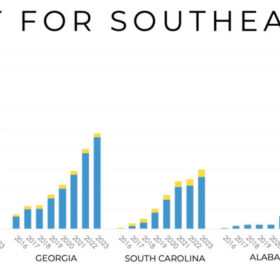
Some states and utilities are driving the growth, while others lag.
From pv magazine USA
The southeastern United States will reach nearly 25 GW of solar by 2023, up from about 10 GW now, according to a new report from the Southern Alliance for Clean Energy (SACE). By 2023, solar will reach 5% of total generation across the region, said the report’s author, Bryan Jacob, in a recent webinar.
Modest growth is projected for distributed solar capacity. SACE made its projections based on publicly available reports and proprietary forecasts.
South Carolina will lead in projected solar per customer for 2023. This is largely because the Energy Freedom Act, passed last year, will “sustain all segments of the vibrant solar market in the state.”
North Carolina, in second place, remains the only state in the southeast with a renewable portfolio standard. “Interconnection delays are constraining the near-term North Carolina forecast (reduced from prior years),” says the report.
In third-ranking Georgia, the Public Service Commission “reinforced its legacy of solar leadership by more than doubling the amount of solar in the Georgia Power 2019 integrated resource plan.”
In Florida, Florida Power & Light won kudos for its state-approved plan to install 1.49 GW of solar through its SolarTogether community solar program, which will “double the amount of community solar” in the United States.
SACE named seven utilities as Sunrisers for their planned increase in solar capacity per customer. The length of each sun ray reflects the utility’s planned solar growth through 2023.
Three utilities are tagged as Sunblockers: TVA, Seminole Electric, and the North Carolina Electric Cooperatives. For each, the utility’s “solar ambition” – the projected solar watts per customer for 2023 – “remains far below” the 2019 regional average of 325 watts per customer.
TVA continues to set policies unfavorable to solar, such as sunsetting the “once exemplary” Green Power Provider program. TVA, a “self-regulated monopoly, not subject to federal or state regulatory oversight, has been promoting misleading claims of solar growth.”
“SunBlockers should look to the SunRisers for how to increase installed solar capacity in their service territories and states,” said Jacob, who serves as solar program director for SACE.
The report includes a summary description for solar capacity and solar policy in each state covered. The SACE report is titled “Solar in the Southeast.” Figures are reported in megawatts (AC), as “AC reporting is becoming increasingly more common, particularly for utility-scale solar projects.”
Lắp đặt điện mặt trời Khải Minh Tech
https://ift.tt/2X7bF6x
0906633505
info.khaiminhtech@gmail.com
80/39 Trần Quang Diệu, Phường 14, Quận 3
Lắp đặt điện mặt trời Khải Minh Tech
https://ift.tt/2ZH4TRU
Không có nhận xét nào:
Đăng nhận xét